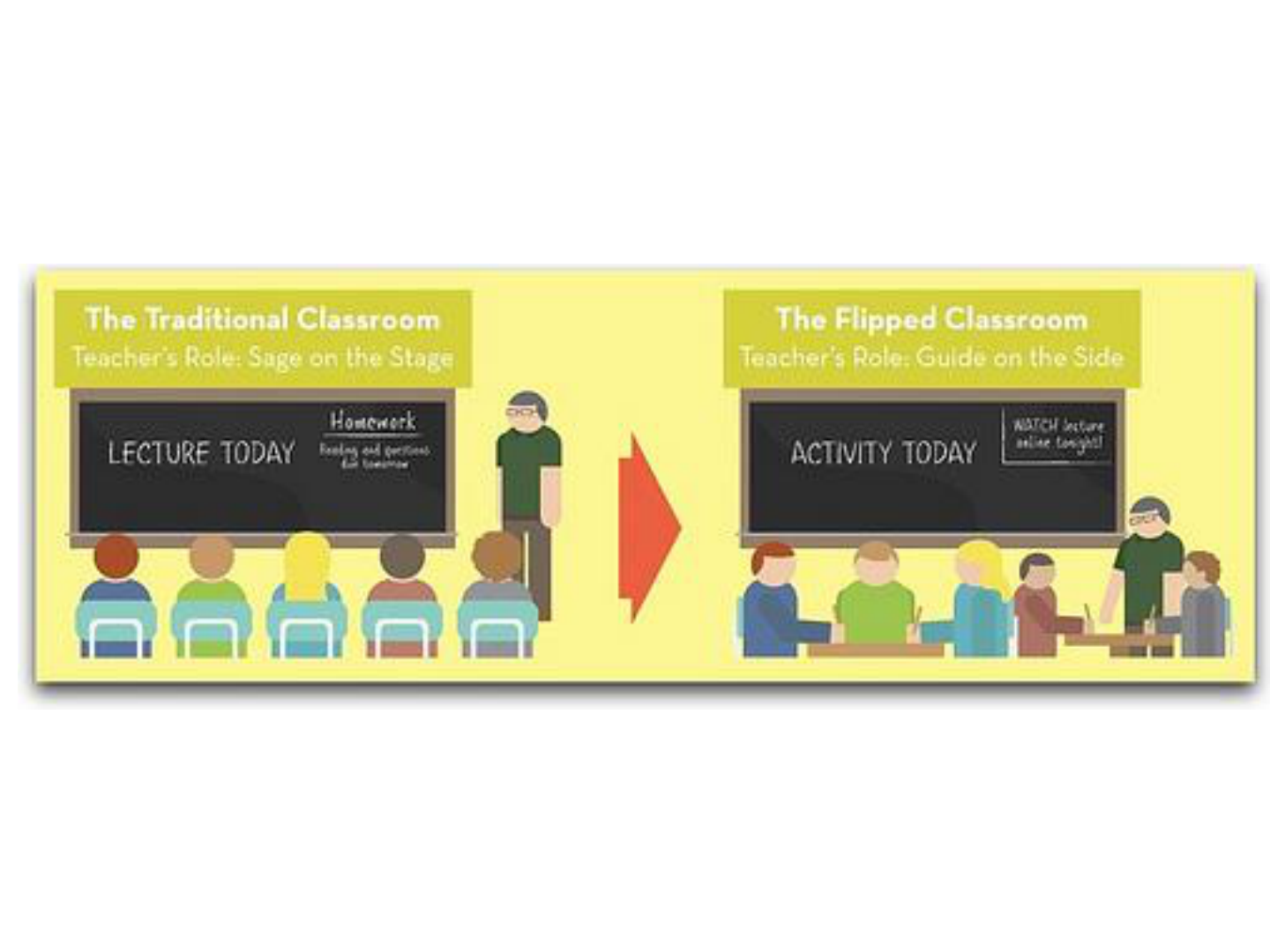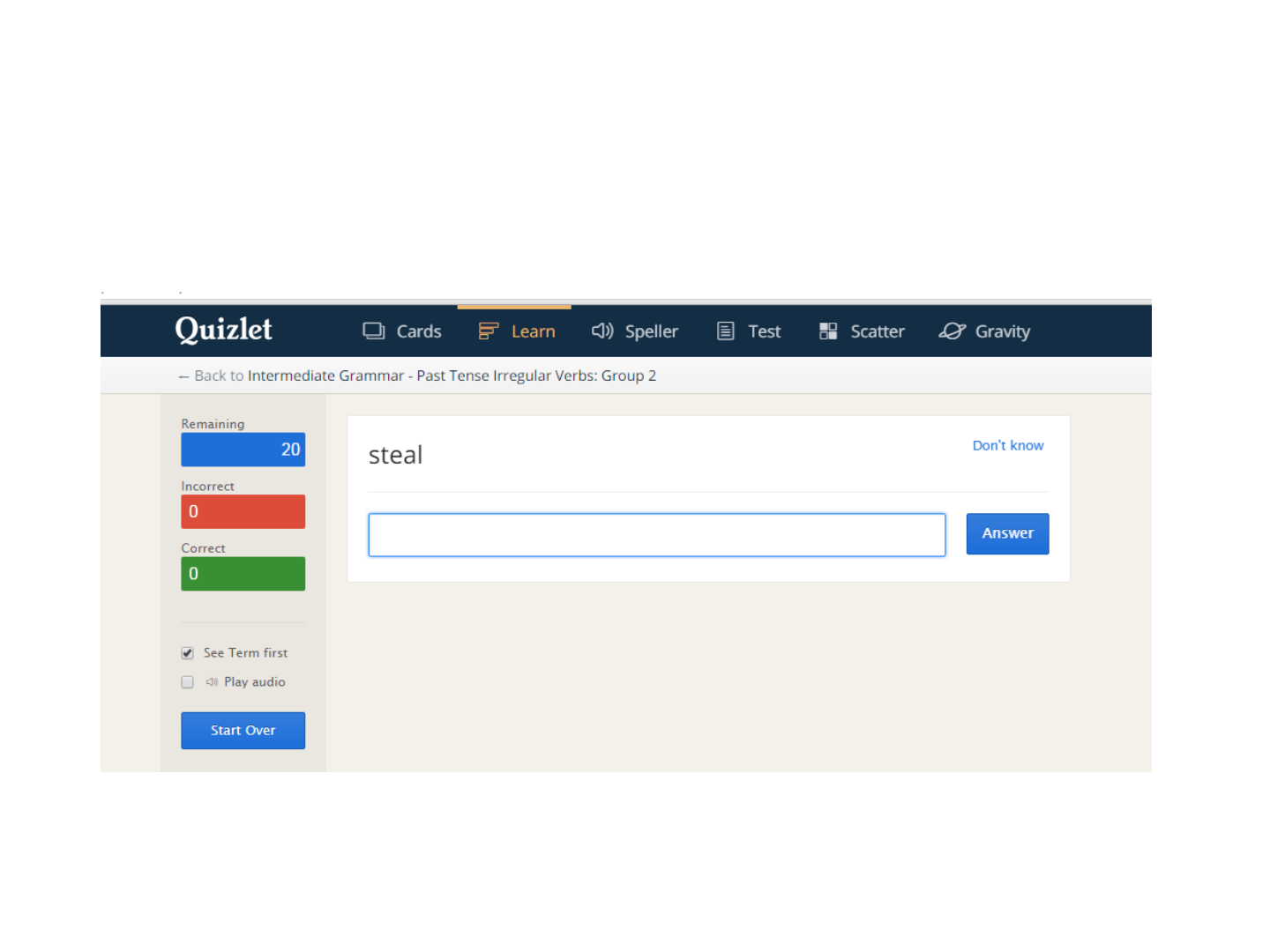
The Flipped Classroom:
Preparing Students for In-Class
Learning with Online Activities
Andrew Screen
American English Webinar

Agenda
• What is “flipped” learning ?
• Why flip learning?
• How can you flip learning?
• Final thoughts (advice) on flipping and integrating
in-class learning with online activities

The Flipped Classroom
http://flippedlearning.org/FLN
• Flipped learning is a pedagogical approach in which
direct instruction moves from the group learning
space to the individual learning space, and the
resulting group space is transformed into a
dynamic, interactive, learning environment where
the educator guides students as they apply
concepts and engage creatively in the subject
matter (Flipped Learning Network).

FLIP: 4 Pillars
• Flexible environment
• learning styles; timelines for learning; learning spaces
• Learning Culture
• Instruction is learner-centered
• Intentional Content
• Class content is designed with flip in mind
• Professional Educator
• Observe, provide feedback, reflect, tolerate “organized
chaos
http://flippedlearning.org/cms/lib07/va01923
112/centricity/domain/46/flip_handout_fnl_w
eb.pdf

“Flipped Classroom”
• “The flipped classroom is a pedagogical model in
which the typical lecture and homework elements
of a course are reversed” (Educause, 2012).

The Flipped Classroom
• “Students gain first-exposure learning prior to class
and focus on the processing part of learning
(synthesizing, analyzing, problem-solving, etc.) in
class.” (Walvoord, Anderson, 1998)

Bloom’s Taxonomy

“Flipped Learning”
• Moving instruction from inside classroom to
outside classroom
• Creating a dynamic, interactive classroom (Flipped
Learning Network).

https://teachmspost.wordpress.com/

“Flipped Lessons”

Peer Instruction
• Students see content before class
• Quizzes are used to make sure students come to
class prepared
• Teacher checks understanding by using polling
questions

Peer Instruction
• If more than ~30% of the class answers incorrectly,
students discuss in small groups
• The instructor provides feedback
• The question is asked again

Past Perfect
Is the form of the past perfect correct in the
following sentence?
I had wrote one paragraph before I went to sleep.
A. Definitely correct
B. Maybe correct
C. Maybe incorrect
D. Definitely incorrect

“Flipping is not for me.”

Flipping with smartphones



“Flipping”
• How MIGHT this apply to my context?
• Listen
• Determine
• Implement or continue
• *In flipping, half of the learning happens in class.

“Traditional” Flip
• In the ESL field, we don’t really lecture; we explain.

“Traditional” Flip
• Traditional flip: students read about a “new”
grammar structure before the teacher “explains” it
• The reading is done for homework

Flip/Flipped/Flipping
• Instruction outside class
• Inside class concept checking/practice
• Why?

Why?
• Why do teachers decide to flip learning?

Why flip learning?
• Time
• Autonomous learning

What’s driving your “learning
train”?

What’s driving your “learning
train”?
• Technology
• “Everybody” is talking about it
• Required
• Student learning



Our students

Why flip?
• Time
• “We didn’t get to that because we didn’t have
time.”
• Time for what?
• How is class time spent?
• How much practice time is there for students?

Why flip learning?
• I’ve flipped my classroom. Now what?
• Derek Bruff, Vanderbilt University
https://cft.vanderbilt.edu/2014/02/ive-
flipped-my-classroom-now-what/

Why flip learning?

Why flip?

Why flip?

Why flip?
• Pacing and individualized learning
• Day 1 of a new unit can be “painful”
• Stronger students = bored
• Students who are not as strong = lost

Why flip?
• Flipping can even the playing field
• Flipping can better prepare students to ask good
questions earlier in the unit
• How?

Day 1
• Flipping day 1 of a unit can eliminate the
metalanguage component
• Why is this a “comma splice”?
• Students can pose basic questions having thought
about the content
• Instruction is not dictated by the pace of the
slowest nor the fastest

Flipped Grammar Project (2012-
2013)
• Georgetown University (Center for Language
Education and Development)
• Initiative Technology Enhanced Learning (ITEL)
• Flipped units in intermediate grammar class
• 300+ hours of materials creation, research, analysis
• *Two classes
https://itel.georgetown.edu/

Research Questions
• The project began with two main research
questions:
• How does a flipped approach impact the type and
extent of learning activities?
• Does flipping the curriculum increase learning
effectiveness?

Our Flipped Context
• Open Learning Initiative (Carnegie Mellon
University)
• Flipped 2 units (past perfect & phrasal verbs)
• Traditionally flipped several units

Our Flipped Context
Outside of Class
• Tech: Students watched
videos and completed
homework in OLI
• Low-tech: Students
read grammar
explanations/charts in
textbook and
completed exercises
In Class
• Concept checking with
clicker
• Practice and feedback

OLI

OLI


What do English Language Learners
(ELLs) think about flipped learning?

Student Reactions
+
• OLI
• Videos
• Immediate feedback
-
• Inductive learning
• Learning from book
• Lack of explanations in
class

Common Student Quote In
Flipped Learning
• “I'm not able to ask questions when I have some
problems understanding something.”

What do ELLs think about
flipping?
• “I don’t know how I am improving, but I am.”

What do ELLs think about
flipping?
• “I suggest when we take one lesson, please don't
move to other lesson before you make sure all of
the student understand 100%.”

What do ELLs think about
flipping?
• “She wanted us to learn by ourselves from the
book…get back to the conventional strategy, which
is using the board.”

Do you think these videos help you
learn?
Advanced
• Not at all: 0
• A little: 0
• Some: 6
• A lot: 10
Intermediate
• Not at all: 0
• A little: 0
• Some: 2
• A lot: 4

What do ELLs think about
flipping?

What do ELLs think about
flipping?
• “I don’t tell my students that the learning is
flipped.”
• Robyn Brinks Lockwood (Stanford University)

3 Learning Strategies To Engage Millennials
We Aren’t That Different -
Video Based Training
• Video production for millennials: keep it short
• Average YouTube video length is ~ 4 minutes
• Millennials (born in early 1980s to early 2000s) prefer
short media to quickly spark interest, keep their attention,
and get to the point
• We are comfortable with video; make it exciting and
concise to help us retain the info
http://www.allencomm.com/blog/2013/05/str
ategies-to-engage-millennials-we-arent-that-
different/

Lessons Learned
• Trust/teacher-student relationship > technology
• “L” in FLIP (Learning Culture)
• Different learning styles and preferences
• “I” in FLIP (Intentional Content)

Lessons Learned

Lessons Learned

The Flipped Classroom: Preparing
Students for In-Class Learning with
Online Activities

Survey of 34 Grammar Students
(Intermediate – Advanced)
• Would you rather…
A. read a grammar explanation in a grammar book?
B. read a grammar explanation online?
C. receive a video link?

Results
• 22/34 preferred videos
• 4/34 preferred reading

Videos
• Intro to Passive (for flipped instruction)
• Find/found (in response to an error)

How to flip?

Online Resources
• Web sites
• Online exercises/quizzes
• Instructional videos
• OSU Flipped ESL
• Papa teach me
• Andrew Screen’s YouTube
• Content videos
• Massive Open Online Courses (MOOCs)
• Khan Academy
• Academic Earth
• Learning tools
• Just the Word
• TED Ed
• Dragon Dictation (app)

Flipping with Less Technology
• Limited Internet access?
• Plan ahead
• Download YouTube videos and use them later
WITHOUT Internet access

Flipping with Less Technology
• Polling in class without clickers?
• Students show fingers
• Students hold up colored paper
• Global temperatures ________________ for many
years.
• are rising
• B. rose
• C. have risen
• D. have raised

Flipping with Less Technology
• Ask yourself “Should I really be flipping?”
• Flipping is good for effective learning because:
• Video can be a more engaging mode than reading
• Video can be replayed
• Video can demonstrate ideas more clearly than
impromptu explanations

Flipping with Less Technology
• How can we model what we want students to do?
• Demonstrate effective strategies
• Show model student work
• Reward students for good behavior
• Give quizzes

Rewind
• Flipping can better prepare students to ask good
questions earlier in the unit

It’s not magic

Scaffolding

How to model effective behaviors
Tech
• Treat videos like
lectures, not movies
• Take notes
• Bring your notes to
class
• Be prepared to ask
questions
• Be prepared to be
quizzed
Low Tech
• Highlight, annotate
• Bring questions to class
• Be prepared to ask
questions
• Be prepared to be
quizzed

Different Perceptions
My view
• You watch video, take
notes, ask questions in
class or office hours.
Student view
• The Google effect: I
have a question right
now; I need an answer
right now.

How can I help my students to be
more autonomous learners?

Classic Student Quote
• “Are you going to teach us?”

Chinese Proverb
• “Your teacher can open the door, but you must
enter by yourself.”


Class time
20%
20%
10%
20%
20%
10%
How should class time be spent? (my
perception)
Explanations/lectures
Pair work
Group work
Independent practice (with
teacher feedback)
Quizzes/tests
HW review

Classic Student Quote
• “We “know” the grammar; we just need to practice
it.”

“Teaching” Verb Tenses: Present, Present
Progressive, Past, Past Progressive,
Present Perfect
• PowerPoint presentation
• Chalkboard explanation
• Handout explanation
• Other

“Teaching” Verb Tenses
• Textbook explanations
• Video explanations
• Discovery task

Unit Progression
• Bloom’s Taxonomy
• Day 1 – Concept checking for recognition
• Day 2 – Error correction/tasks
• Day 2/3 - Tasks

Application

FLIP (Professional Educator)
• Provide feedback
• Students want corrective feedback
• Output without focus/attention is less meaningful

Practice + Feedback = Engaged
Students
• Students LIKE authentic tasks
• Students LIKE feedback
• Do happy, engaged students = better learners?

How to Flip…

VoiceThread
• I video record my explanation of the syllabus
• Students watch the video (before FIRST DAY of
class)

Syllabus Delivery via VoiceThread

Syllabus Delivery via VoiceThread

The Syllabus
• Syllabus overview = 15, 20, 30 minutes???
• Millennials listening to a syllabus explanation for
that long?
• New students and continuing students receiving
the same information at the same pace?

Syllabus Delivery via VoiceThread
• Reading/Watching my syllabus explanation
becomes homework
• We spend 15, 20, 30 minutes checking
understanding of syllabus
• Clickers questions (pairs, teams) – “gamification”

The Flipped Syllabus (low tech)
• Students read syllabus for homework
• Students answer syllabus questions in teams
• Correct answers can be discussed (pairs, groups,
whole class)
• *Scavenger hunt

How to flip?

Model the tools
• Just the Word
• Quizlet
• Dragon Dictation (app)

Just The Word
• Student says “make research”
• Solicit collocations with “research”
• ___________ research
• Test their predictions
• This is a form of “gamification”

Gamification
• Gamification is the application of game-design
elements and game principles in non-game
contexts (Wikipedia).

Quizlet

Quizlet
• Student writes “heared” instead of “heard”
• Open Quizlet and play the spelling game for 1
minute
• The 1-minute “teaser” has them addicted
• Students practice on Quizlet for homework
• This is a form of “gamification”

Dictation App (Dragon)
• Curious how you could use this with your students?
• Check out the supplemental materials for the
webinar

Shared Class Notes: Google Doc
• This is a doc that is shared with everyone in the
class
• The doc remains open during class
• I type anything I used to write on the chalkboard
here
• Students are quizzed on the content in the doc
regularly

Shared Class Notes: Google Doc

EduCanon

EduCanon
• This can be used in class
• Students vote on best answer
Or…
• This activity can be assigned for homework for
listening/grammar practice

Immediate Feedback

Final thoughts (advice) on Flipping
and integrating in-class learning with
online activities

Advice
• Know your context
• Identify a problem or an area that could be
“improved”
• Start small
• Solicit feedback
• Iterate
• Repeat
• Mistakes are good learning opportunities, BUT
minimize mistakes by piloting with low stakes

Advice
• Ask yourself, “How can I get my students to achieve
the learning outcomes most efficiently?”

Sources
• http://flippedlearning.org/FLN
• http://flippedlearning.org/cms/lib07/va01923112/cent
ricity/domain/46/flip_handout_fnl_web.pdf
• https://net.educause.edu/ir/library/pdf/ELI7081.pdf
• https://teachmspost.wordpress.com/
• http://www.press.umich.edu/7110704/flip_it!/?s=look
_inside
• https://cft.vanderbilt.edu/2014/02/ive-flipped-my-
classroom-now-what/
• https://itel.georgetown.edu/
• http://www.allencomm.com/blog/2013/05/strategies-
to-engage-millennials-we-arent-that-different/

Sources
• Crouch CH and Mazur E (2001). Peer instruction:
Ten years of experience and results. American
Journal of Physics 69: 970-977.
• Walvoord BE, and Anderson VJ (1998). Effective
grading: A tool for learning and assessment. San
Francisco: Jossey-Bass.


